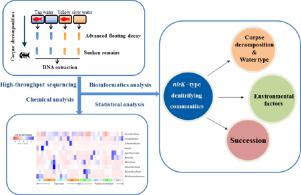Science of the Total Environment ( IF 8.2 ) Pub Date : 2020-08-06 , DOI: 10.1016/j.scitotenv.2020.141472 Qiaoling Yu 1 , Rui Zhou 1 , Yijie Wang 1 , Tianshu Feng 1 , Huan Li 2

|
Cadaver decomposition as high-quality nutrient inputs may exert strong perturbation on the aquatic environments, such as high nitrogen or nitrate pollution. Denitrifying bacteria may reduce nitrate to nitrogen gas, thereby decreasing the nitrogen pollution and improving self-purification ability of aquatic ecosystem. However, how nirK denitrifying communities in water respond to cadaver decomposition remains unknown. Thus, we employed high-throughput sequencing and chemical analysis to investigate the succession of nirK-type denitrifying communities in tap water and Yellow river water (experimental groups) as well as their corresponding control groups during two important stages of fish corpse decomposition called advanced floating decay and sunken remains. Our data showed that the concentration of NH4+-N in the experimental groups increased approximately 3–4 times compared with the control groups. Proteobacteria was the predominant phylum for nirK denitrifying communities. Several potential pathogenic genera, such as Brucella and Achromobacter, were enriched in the corpse groups. Notably, nirK-type community structures were significantly impacted by cadaver decomposition. Community structures in the corpse groups become more similar with succession, indicating community convergence at the final stage. Water pH, oxidation-reduction potential (ORP) and treatment were three important factors affecting the community structures. However, water type was not a main driving factor determining carcass-associated nirK-type bacterial communities. Four phylogenetic clusters were detected in the denitrifying communities, but showed significantly different distribution between the corpse and control groups. These results provide an in-depth understanding for nirK denitrifying functional bacteria and potential pathogenic bacteria during carrion decomposition process, which offer valuable reference to environmental evaluation and management.
中文翻译:

尸体分解增加了氮污染,并改变了不同水类型中nirK型反硝化群落的演替。
尸体分解为高质量的营养物输入可能会对水环境造成强烈干扰,例如高氮或硝酸盐污染。反硝化细菌可以将硝酸盐还原为氮气,从而减少氮污染并提高水生生态系统的自净能力。但是,水中的NirK反硝化群落对尸体分解的反应仍然未知。因此,我们使用高通量测序和化学分析来研究nirK的继承自来水和黄河水(实验组)及其对应的对照组中的两种类型的反硝化群落,它们处于鱼尸体分解的两个重要阶段,称为高级漂浮衰变和沉没残骸。我们的数据表明,与对照组相比,实验组中NH 4 + -N的浓度增加了约3-4倍。细菌是nirK反硝化群落的主要门。尸体组中丰富了几种潜在的病原属,例如布鲁氏菌属和无色杆菌属。值得注意的是,nirK型群落结构受到尸体分解的显着影响。尸体群体中的社区结构随着继承而变得更加相似,这表明社区在最后阶段趋于一致。水的pH值,氧化还原电位(ORP)和处理是影响群落结构的三个重要因素。但是,水类型不是决定与car体相关的nirK型细菌群落的主要驱动因素。在反硝化群落中检测到四个系统发育簇,但在尸体组和对照组之间显示出明显不同的分布。这些结果为nirK提供了深入的了解 在腐肉分解过程中对功能细菌和潜在病原细菌进行反硝化处理,为环境评估和管理提供了有价值的参考。













































 京公网安备 11010802027423号
京公网安备 11010802027423号